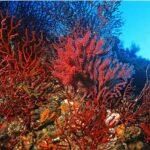Again, California is burning. For a week now (since September 7th) wildfire season on the West Coast has created a living inferno, and this is just the beginning. With an unprecedented 5 million acres ablaze and 90 wildfires, this is the West Coast’s worst fire season on record. Yet, as autumn approaches more destruction is on the horizon: autumn is California’s driest season and typically has strong tropical winds—not the ideal scenario to calm down the already scorching tinderbox. Images of a red San Francisco skyline blanketed by ash and smoke have made headlines, but what is really going on? Why does California have a fire season every year? The answer is four-fold:
1. Climate Change
-
- A heat wave baked Southern California last week (September 6th 2020) Los Angeles County hit a record 121F / 49C and Death Valley recently reached 130 degrees, which would be the highest temperature ever reliably recorded on the planet
- California gets most of its moisture in the fall and winter. Its vegetation then spends much of the summer slowly drying out due to a lack of rainfall and rising temperatures. That vegetation then serves as kindling for fires and can be lit aflame from any spark: human caused or natural eg. lightning.
- Historically, northern forests had too much moisture for fires to ignite, however climate change is drying out these forests, and without moisture they have no protection from conflagarations.
2. People
-
- More often than not humans unintentionally light the spark. Lightning sparked wildfires occur sporadically, around once every 10 years. So here some examples of how humans sparked fires:
- Many deadly fires have been started by downed power lines.
- The 2018 Carr Fire, the state’s sixth-largest on record, was ignited when a truck blew out its tire and the rim scraped the pavement, sending out sparks.
-
- Last week a gender-reveal party’s fireworks sparked Los Angeles’ wildfire that consumed thousands of acres.
-
3. Fire Suppression
-
- For thousands of years, Native American tribes in California would regularly burn the landscape to steward the land, but colonization led to the suppression of these tactics (known as Fire Suppression) along with decades of misguided policy.
- Intentionally burning areas of forests would work in mitigating fires because the already burnt areas would stop wildfires from expanding and growing. This is why the summer California wildfires are known as “fuel” driven, because they have lot’s of timber to burn through.
- A resumption in this forestry practice of managed burning in higher and northern areas would lessen the severity of the fire season
4. Santa Ana Winds
-
- California has two fire seasons: from June – September driven by warmer and drier weather (usually in northern areas) and from October – April driven by the Santa Ana winds (usually in densely populated coastal areas).
- The latter tend to spread 3x faster and burn closer to urban areas. As they’re not timber driven it burns through anything.
You would think that the government’s annual high cost of fire mitigation and damage control would lead them to strengthen its forestry management and climate policies. Perhaps to eventually ensure Californians can have a safe home. Well think again. This is what Trump has to say about California:
WADE CROWFOOT: If we ignore that science and sort of put our head in the sand and think it’s all about vegetation management, we’re not going to succeed together protecting Californians.
PRESIDENT DONALD TRUMP: OK. It’ll start getting cooler. You just —
WADE CROWFOOT: I wish —
PRESIDENT DONALD TRUMP: You just watch.
WADE CROWFOOT: I wish science agreed with you.
PRESIDENT DONALD TRUMP: I — well, I don’t think science knows, actually.
So remember, your vote is important this coming November.
Sources: NYT & Democracy Now













